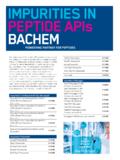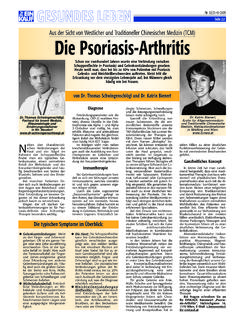Transcription of Coupling Reagents - Bachem
1 NHCOOHRHC PG1NH2 COORHC PG2 NHCORHC PG1 NHCOORHC PG2 COUPLINGREAGENTSC oupling Reagents2 Coupling Reagents AND ADDITIVES OFFERED BY BACHEMThe Coupling reaction the formation of an amide bond between amino acids and/or peptides is the crucial step in peptide synthesis. The reaction consists of two con-secutive steps:1. Activation of the carboxy moiety2. Acylation of the amino groupDuring the first step the protected amino acid (or pep-tide) reacts with a so-called Coupling reagent yielding a reactive intermediate. The chemistry behind and the most important Coupling Reagents will be presented in this brochure. PEPTIDE SYNTHESISOur comprehensive offer of Coupling Reagents , amino acids derivatives and further building blocks, and resins at will fulfill the needs of solid-phase and solution peptide synthesis.
2 If the product you need is lacking, please let us know. Activation during Peptide SynthesisThe formation of an amide bond between a carboxylic acid moiety and an amino func-tion of two amino acids is the core reaction in peptide synthesis: could be isolated if desired. During the second step (II. in Fig. 1), A is attacked by a nucleophile such as the -amino group of a carboxy-protected amino acid. Steps I and II can be performed either consecutively or, with certain types of Coupling Reagents , as a one-pot reaction. Over the years, numerous activation methods have been developed, such as the generation of carboxylic halides (chlorides, fluorides), carboxylic azides, symmetrical or mixed anhydrides or the use of carbodi-imides (DCC, DIC, EDC HCl) with or without additives.
3 The first step of this condensation reaction, the activation of the carboxyl moiety (I. in Fig. 1) is often the critical one. Depend-ing on the type of activating reagent, the intermediate A is a stable compound which 3If the amino compound contains other func-tional groups able to take part in the coupl-ing reaction, use of a stable preactivated carboxylic compound A is recommended. Active esters such as the pentafluorophe-nyl (OPfp) and hydroxysuccinimido (OSu or NHS) esters are reactive amino acid deriva-tives finding broad application in peptide synthesis. For our comprehensive offer of active esters please see our online ReagentsCarbodiimides have been used as activa-tors for decades in solid-phase and solution peptide synthesis. They still hold their place, though in recent years two classes of cou-pling Reagents became popular, the phos-phonium- and the aminium-(imonium-)type Reagents such as BOP, PyBOP, PyBrOP, TBTU, HBTU, HATU, COMU, and TFFH.
4 These compounds achieve high Coupling rates ac-companied by few undesired side contrast to activation by carbodiimides, peptide couplings using the latter com-pounds require the presence of a base. Di-isopropylethylamine (DIPEA) and N-methyl-morpholine (NMM) are the most frequently used ones in Fmoc/tBu-based solid-phase synthesis. In cases of a markedly increased risk of racemization, the weaker base has been recommended for substituting DIPEA or NMM. Racemization is one of the main side reac-tions, when activating carboxyl groups of amino acids (except for glycine or proline). Electron-withdrawing groups bound to the -amino moiety ( acyl, peptidyl ( fragments)) increase the NONE OF THE Coupling Reagents IS APPLICABLE TO ALL TYPES OF Coupling REACTIONSFig. and cou-pling of a protected amino , PG : protecting groupsAct: activating groupCoupling Reagents4tendency to racemize considerably.
5 Ure-thane derivatives, which include standard -amino protecting groups as Fmoc, Boc, and Z, of amino acids usually retain their optical purity upon activation. The mecha-nism of racemization (Fig. 2) involves the abstraction of the -hydrogen from the -carbon atom of the activated amino acid, either by direct formation of an enolic in-termediate (direct -abstraction, path A) or by formation of a 5-membered oxazolinone ring (path B), which isomeric aromatic con-figuration is readily formed in the presence of other side reactions have been described so far, depending on the type of side chain functionalities, the combination of protecting groups, the reactivity of the carboxyl group, or the basicity of the amino function. They will be mentioned later as special information for the respective cou-pling Coupling reagent has its individual advantages and drawbacks.
6 None of them will render good results for all types of amino acid derivatives!This brochure gives information on a large number of currently available Coupling Reagents , their scope and limitations. We hope that it can help the chemist to make the appropriate Reagents and Additives1. CarbodiimidesDCC(Dicyclohexylcarbodiimid e)This popular condensation reagent has been applied for Coupling since 1955 and is still much in use today. DCC is routinely applied in solution as well as in solid-phase peptide synthesis, mostly in combination with additives such as HOBt or HOSu in order to reduce epimerization in the case of peptides or racemization in the case of amino acids. Couplings in solution with amino acid derivatives provided as salts ( hydrochlorides) require one equivalent of a tertiary base (as NMM).
7 Else, the reac-tion does not require additional base, so that racemization can be kept of DCC in solid-phase synthesis is limited due to the by-product dicyclohex-ylurea (DCU) with is formed simultaneously with the Coupling reaction (see Fig. 3). This by-product is sparingly soluble in most solvents, and therefore DCC should better be replaced by other carbodiimides DIC (diisopropylcarbodiimide).Fig. of base-catalyzed racemization during , in the manufacture of active esters, DCC is still one of the Reagents of choice. In solution, the low solubility of DCU turns into an advantage of this activation of preformed OPfp esters re-duces the risk of concomitant racemization during couplings. Fmoc-AA-OPfp-esters can be isolated and purified by crystal-lization. They are stable but highly reactive building blocks routinely used for couplings in fully automated :J.
8 C. Sheehan and G. P. Hess, J. Am. Chem. Soc. 77, 1067 (1955)G. W. Anderson and F. M. Callahan, J. Am. Chem. Soc. 80, 2902 (1958) n and , Synthesis 303 (1986)DIC(Diisopropylcarbodiimide)DIC (or DIPCDI) is a useful reagent for au-tomated SPPS, because the corresponding urea is soluble in standard solvents such as isopropanol and can be washed out more readily than the one obtained from DCC. If base-free conditions are required as to minimize racemization, the combination of DIC and HOBt (or HOAt, Oxyma Pure) is still one of the best methods for Coupling Fmoc-Cys(Trt) :A. Williams and I. T. Ibrahim, Chem. Rev. 81, 589 (1981)L. A. Carpino, A. El-Faham, Tetrahedron 55, 6813 (1999)EDAC HCl, EDC HCl, WSC HCl (Q-1955)(N-(3-Dimethylaminopropyl)-N -ethylcar-bodiimide HCl) This water-soluble carbodiimide was es-pecially designed for couplings in aqueous solution, even though the stability of the Fig.
9 Amide bond Reagents6reagent under these conditions is limited. Normally, EDAC-mediated couplings are performed in polar solvents such as DMF or NMP or even in methylene chloride. EDAC has also been employed in SPPS on highly polar resins compatible with water-con-taining solvents. Contrary to DCU, the urea formed from EDAC is readily soluble. EDAC is the reagent of choice for the con-jugation of peptides, labels, small organic molecules etc. to :J. C. Sheehan, P. A. Cruickshank, G. L. Boshart, J. Org. Chem. 26, 2525 (1961)K. D. Kopple and , J. Am. Chem. Soc. 84, 4457 (1962)J. C. Sheehan, J. Preston, P. A. Cruickshank, J. Am. Chem. Soc. 87, 2492 (1965)K. Hojo, H. Ichikawa, Y. Fukumori, K. Kawa-saki, Int. J. Pept. Res. Ther. 14, 373 (2008)Y. J. Pu, R. K . Vaid, S. K . Boini, R.
10 W. Towsley, C. W. Doecke, D. Mitchell, Org. Process Res. Dev. 13, 310 (2009)In addition to racemization another side reaction with carbodiimides is an O-N-migration of the activated carboxyl func-tion forming an N-acyl urea (see Fig. 3). This stable compound is unable to take part in further couplings reaction. As this side reaction depends on the temperature and Coupling behavior of the correspond-ing amino function, low temperatures are always recommended in carbodiimide-mediated to the fact, that all carbodiimides are condensing Reagents , side reactions of un-protected amino acid-side chains (Asn, Gln), such as conversion of amides to nitriles have been observed. Appropriate side-chain protecting groups will prevent these side side reactions depending on the na-ture of additives are not a special problem of carbodiimides and will be described of the DCC/HOBt-mediated peptide AdditivesAdditives such as HOBt, HOAt or Oxyma pure are strongly recommended in all cases of amide bond formations with car-bodiimides, in order to enhance the reactiv-ity and also to reduce formation of epimers as well as (1-Hydroxybenzotriazole)N-Hydroxybenzotr iazole, developed by W.









